John Wolff's Web Museum
"Facit" Calculators
Contents
|
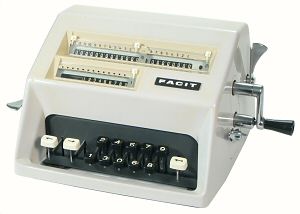
|
| Facit Model C1-13, c.1971. |
Overview.
 The "Facit" company was established in Stockholm in 1918 to build
a line of pin-wheel calculators based on the
Odhner mechanism.
The "Facit" company was established in Stockholm in 1918 to build
a line of pin-wheel calculators based on the
Odhner mechanism.
In 1924 Facit became part of Atvidaberg Industries, a
long-established firm of office furniture and equipment suppliers.
Facit production moved to Atvidaberg, and the model range developed
rapidly. As the firm grew it absorbed the Halda typewriter company
in 1938, Original-Odhner in 1942, and Addo in 1966. At its peak the
company had over a thousand employees, with sales agents in a
hundred countries, before collapsing in the early 1970s.
The early Facit calculators were similar to the Odhner, with
rotary setting levers and a moving carriage which extended beyond the
body of the machine. In the early 1930s engineer Karl Rudin made a
radical design change which retained the pin-wheel principle but
eliminated the external moving carriage. The pin-wheel mechanism was
effectively turned upside-down, with the accumulator and counter
registers being fixed in position at the top of the machine, and the
rotor arranged to travel laterally within the confines of the body.
At the same time, the rotary setting levers were replaced with the
two-row "Dalton" keyboard mechanism. The operating levers and the
cranking handle were the only external moving parts.
This "inverted" pin-wheel mechanism formed the basis of the Facit
model range for the next 40 years. Beginning with the Model T in
9 x 8 x 13 format in 1932, the machine progressed
through the Model TK (1936) and the NTK (1954) to the C1-13 of 1957,
which continued with only minor changes into the early 1970s. The same
mechanism formed the basis of the first motor-driven range, which
progressed through several models into the fully-automatic CA1-13
of 1956. A 16-digit mechanism with back-transfer and a 10-key
numeric keypad was introduced as the manual Model CM2-16 in 1959.
The fully-automatic CA2-16 followed in 1962, with an updated Model
10-07 in 1967. The 13 and 16-digit mechanisms were both manufactured
in parallel until the end of production in about 1973.
In 1966 Facit introduced the first of a range of electronic
calculators manufactured by
Sharp
in Japan. The Facit machines had their own distinctive case designs,
but the internals were generally similar or identical to the machines
sold under Sharp's own brand. The electronic machines were sold in
parallel with Facit's traditional mechanical calculators, but were
initially much more expensive. The prices reached parity in about
1972, which effectively marked the end of mechanical calculator
production.
Click on the photos below for larger illustrations.
Traditional pinwheel calculators.
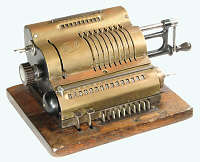 Facit "Standard"
Facit "Standard"
Digits: 9 keyboard, 10 counter, 15 accumulator
Dimensions: 170W x 170D x 140H, overall width 310mm
Weight: 6.8 kg
Manufactured: Sweden, 1924-1931
The "Standard" was the second machine to carry the Facit brand,
and the first to be built under Atvidaberg Industries.
This is an early machine from the 1920s, on an original wooden
base. The base has been shortened on the right-hand side at some
stage in its 80-year history, and the cover has been lost. The
mounting for the the lock can be seen towards the right-hand front,
at what would once have been the centre.
The rotor has 9 places, with a quick-clearing lever at the
left-hand side. The 10-digit counter register is fixed in the body of
the machine above the setting levers, with a 15-digit accumulator
mounted in the moving carriage. The tens-carry on the accumulator
extends to 13 places, with an overflow bell mounted externally on
the left-hand end of the carriage. The counter and accumulator are
cleared with just half a turn of the large wing nuts.
The counter register on this machine uses complementary red and
white figures. Later versions (1928-31) provided a full tens-carry
mechanism.
The carriage can be moved one step in either direction by pressing
the two keys at the left front of the machine, or it can be moved
continuously by turning the large knob on the left-hand side. One
of the ten keys along the front is pressed down to raise an internal
stop, and the knob is turned to bring the carriage rapidly to the
required position. The stop keys are numbered on the metal escutcheon
plate, and the active position is clearly shown through a peep-hole
above the centre of the carriage. The positioning mechanism operates
through a lead-screw, so that the carriage remains firmly in place
with no ratchets or detents.
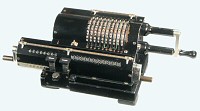 Facit Model S, S/N 200631, 1935
Facit Model S, S/N 200631, 1935
Digits: 10 keyboard, 8 counter, 13 accumulator
Dimensions: 175W x 130D x 120H, overall width 350mm
Weight: 5.3 kg
Manufactured: Sweden, 1935-1954
Facit's traditional pinwheel design was replaced by the ten-key
Model T in 1932. The demand for the earlier design obviously
continued, as Facit found it necessary to reintroduce a conventional
pinwheel model in 1935. In spite of the name on the
rear panel, the
Facit Model S is actually an Original-Odhner Model 7. Odhner apparently
had a working relationship with Facit long before they were taken over
in 1942.
The Odhner Model 7 is a basic pinwheel machine whose only "extra"
feature is a push-button clearing mechanism for the rotor. There is no
setting dial, no back-transfer, and no tens-carry on the counter. The
Model 7 continued in production as the Facit Model S until 1954. The
machine illustrated is an early example from 1935.
Manual ten-key calculators - with 2-row keyboard.
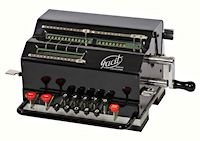 Facit Model TK, S/N 61905, 1941
Facit Model TK, S/N 61905, 1941
Digits: 9 keyboard, 8 counter, 13 accumulator
Dimensions: 210W x 185D x 145H, overall width 300mm
Weight: 6.0 kg
Dalton keyboard, black sheet-metal covers
Manufactured: Sweden, 1936-1954
The first of the Facit "inverted" pinwheel calculators was the
Model T from 1932. The Model TK from 1936 is essentially the same
machine with a number of mechanical improvements. Although model
numbers and exterior styling changed frequently, this basic ten-key
mechanism continued in production with only minor changes for
almost 40 years, from the mid-1930s into the 1970s.
The Facit TK illustrated was made in 1941, but has never been used.
When purchased at auction in the 1970s it was still wrapped in its
original rust-inhibiting paper and packaging, inside its
carrying case. The
high-gloss black paint is still in showroom condition, and the
mechanism is still in full working order.
The Facit name and the manufacturers details are painted onto the
front and back panels respectively. The word "Patent" is stamped
into the back panel, with the serial number on the base.
Facit TK in carrying case.
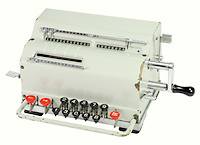 Facit Model TK, S/N 54254, 1937
Facit Model TK, S/N 54254, 1937
Digits: 9 keyboard, 8 counter, 13 accumulator
Dimensions: 210W x 185D x 145H, overall width 300mm
Weight: 6.0 kg
Dalton keyboard, grey sheet-metal covers
Manufactured: Sweden, 1936-1954
Calculating machines were often repainted when returned to their
dealers for major overhauls. This 1937 TK, originally in black as
above, was "updated" to the new Facit grey colour scheme when
overhauled sometime around 1960. The only identification remaining
is the word "Patent" and the serial number stamped into the
back panel.
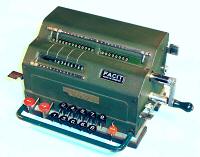 Facit Model TK, S/N 179256, 1948
Facit Model TK, S/N 179256, 1948
Digits: 9 keyboard, 8 counter, 13 accumulator
Dimensions: 210W x 185D x 145H, overall width 300mm
Weight: 6.0 kg
Dalton keyboard, green sheet-metal covers
Manufactured: Sweden, 1936-1954
This Model TK from the late 1940s has a slightly fancier green
sheet-metal case with a pressed-metal "Facit" logo. The agent's
transfer on the front is from "Sydney Pincombe Pty Ltd" of Sydney,
Melbourne, and Hobart. The serial number is stamped underneath.
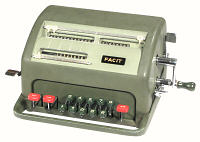 Facit Model NTK, S/N 507834, 1957
Facit Model NTK, S/N 507834, 1957
Digits: 9 keyboard, 8 counter, 13 accumulator
Dimensions: 220W x 200D x 150H, overall width 300mm
Weight: 6.3 kg
Dalton keyboard, green die-cast cover
Manufactured: Atvidaberg-Facit, Sweden, 1954-1957
In the early 1950s Atvidaberg commissioned Sigvard Bernadotte, a
distinguished silversmith and industrial designer (and a member of the
Swedish royal family) to design new casings for the Facit machines and
for the Original-Odhner 200-series.
The re-styled "New TK" was released as the Model NTK in 1954,
with the sheet-metal covers being replaced with a three-piece die-cast
casing in two-tone green. The cover has no visible screws, but is held
in place by two spring clips concealed in the holes for the clearing
levers. The octagonal keytops have been replaced by round for the
numerals and rectagular for the shift controls. The maker's details
and serial number are on a large aluminium plate on the base of
the machine. The operation of the machine was unchanged, but there
were a mumber of internal changes to refine the details of the
mechanism and to simplify the construction.
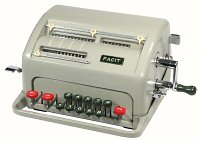 Facit Model NTK, S/N 507837, 1957
Facit Model NTK, S/N 507837, 1957
Digits: 9 keyboard, 8 counter, 13 accumulator
Dimensions: 220W x 200D x 150H, overall width 300mm
Weight: 6.3 kg
Dalton keyboard, grey die-cast cover
Manufactured: Atvidaberg-Facit, Sweden, 1954-1957
Another 1957 version of the Facit NTK in a plain grey case. Note
that the serial number is only 3 greater than the previous machine.
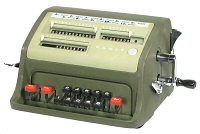 Facit Model C1-13, S/N 556608, 1957
Facit Model C1-13, S/N 556608, 1957
Digits: 9 keyboard, 8 counter, 13 accumulator
Dimensions: 225W x 210D x 150H, overall width 310mm
Weight: 6.6kg
Dalton keyboard, green die-cast cover
Manufactured: Atvidaberg-Facit, Sweden, 1957-1972
New model numbers were allocated in 1957, with the TK-style machines
becoming Model C1-13. The mechanism did not change significantly, but
the case and clearing levers were re-styled, the numeral keys became
square, and the Facit badge became round. This 1957 machine is still
finished in the earlier two-tone green, with the Facit name spelled out
across the back on a row of separate small round buttons. The
metal-foil label above the
registers was prepared by the local agents as a conversion table from
pence to decimals of a pound. A more
technical label was available for scientific and engineering
applications.
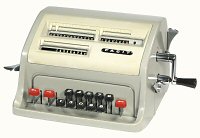 Facit Model C1-13, S/N 851412, 1963
Facit Model C1-13, S/N 851412, 1963
Digits: 9 keyboard, 8 counter, 13 accumulator
Dimensions: 225W x 210D x 150H, overall width 310mm
Weight: 6.6kg
Dalton keyboard, grey die-cast cover
Manufactured: Atvidaberg-Facit, Sweden, 1957-1972
The second version of the C1-13 has a two-tone grey colour scheme.
The round metal name badge on the front of the machine has been
replaced with a moulded plastic badge with rounded ends. The rear
panel still has the Facit name spelled out on separate round buttons.
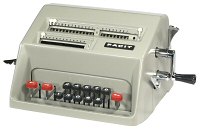 Facit Model C1-13, S/N 899682, 1966
Facit Model C1-13, S/N 899682, 1966
Digits: 9 keyboard, 8 counter, 13 accumulator
Dimensions: 225W x 210D x 155H, overall width 310mm
Weight: 6.2 kg
Dalton keyboard, grey die-cast cover
Manufactured: Atvidaberg-Facit, Sweden, 1957-1972
This mid-1960s version of the C1-13 has a much more angular die-cast
housing finished in a monotone medium-grey gloss. The front name
badge is larger with rectangular ends, and there are larger square
letters across the back.
 Facit Model C1-13, S/N 946810, 1967
Facit Model C1-13, S/N 946810, 1967
Digits: 9 keyboard, 8 counter, 13 accumulator
Dimensions: 225W x 210D x 155H, overall width 310mm
Weight: 6.2 kg
Dalton keyboard, grey die-cast cover
Manufactured: Facit AB, Sweden, 1957-1972
The nameplate of this 1967 machine reflects the change in company
name from Atvidaberg-Facit to Facit AB in 1966. The colour scheme has
changed to a very light grey, with a black base and keyplate and white
shift keys. The mechanism is basically identical to the
previous versions.
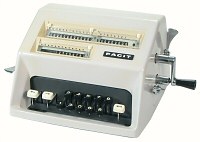 Facit Model C1-13, S/N 2405940, 1971
Facit Model C1-13, S/N 2405940, 1971
Digits: 9 keyboard, 8 counter, 13 accumulator
Dimensions: 230W x 210D x 160H, overall width 310mm
Weight: 5.8 kg
Dalton keyboard, die-cast base, grey plastic cover
Manufactured: Facit AB, Sweden, 1957-1972
This 1971 machine was the final version of the C1-13. The die-cast
housing has been replaced by moulded plastic in a medium grey, with
a pale yellow background around the registers. Production ended in
Sweden in 1972, but the C1-13 was reportedly still made in India
into the 1980s.
Manual ten-key calculators - with high-capacity carriage.
 Facit Model LX, S/N 103604, 1948
Facit Model LX, S/N 103604, 1948
Digits: 10 keyboard, 10 counter, 19 accumulator
Dimensions: 220W x 210D x 160H, overall width 410mm
Weight: 7.8 kg
Dalton keyboard, green sheet-metal covers
Manufactured: Sweden, 1938-1954
The Facit Model LX from 1938 combined the inverted pinwheel
mechanism with a moving carriage to provide a high-capacity machine
with 10 places in the rotor, 10 in the counter, and 19 in the
accumulator. The extended capacity provided the greater precision
needed in many technical fields (eg surveying), but also simplified
other complex calculations by allowing temporary storage of
intermediate results at different locations along the 19-digit
accumulator.
The appearance and internal mechanism of the LX are very similar to
those of the Model TK (above), except that the registers are mounted in
the moving carriage. The carriage fits neatly into the top of the
machine, so that the register windows appear in the same positions as
on the TK. The register clearing levers are mounted on the ends of the
carriage rather than on the body of the machine. The winding handle
has been lengthened to provide clearance when the carriage is in its
right-most position. The setting keys move the rotor in the usual
manner, but the left and right shift keys move the carriage one place
at a time (up to 9 places). A lever at the left-hand end of the
carriage allows rapid end-to-end movement.
 Facit Model NLX, S/N 500108, 1954
Facit Model NLX, S/N 500108, 1954
Digits: 10 keyboard, 10 counter, 19 accumulator
Dimensions: 220W x 210D x 160H, overall width 410mm
Weight: 7.9 kg
Dalton keyboard, green sheet-metal covers
Manufactured: Sweden, 1954-56
The Model NLX replaced the LX in 1954. The only obvious external
difference is in the rotor clearing handle, which now travels
horizontally rather than vertically. Internally, however, the machine
incorporated a host of changes to refine the details of the mechanism
and to simplify the construction.
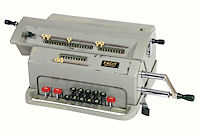 Facit Model C1-19, S/N 520498, 1956
Facit Model C1-19, S/N 520498, 1956
Digits: 10 keyboard, 10 counter, 19 accumulator
Dimensions: 250W x 215D x 160H, overall width 450mm
Weight: 8.8 kg
Dalton keyboard, die-cast covers
Manufactured: Sweden, 1956-60
The Model C1-19 replaced the NLX in 1956. The mechanism was largely
unchanged, but the sheet-metal covers were replaced with die-cast alloy
mouldings similar to those of the new Model NTK (above). The winding
handle and the register clearing handles are similar to those used on
the Original-Odhner 200-series machines from the same period. This
early C1-19 was originally used in the Brisbane offices of Mount Isa
Mines. It was originally painted green, but has been "updated" twice
during its working life with two different shades of grey.
Manual ten-key calculators - with 10-key keypad.
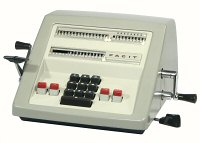 Facit Model CM2-16, S/N 1081539, 1965
Facit Model CM2-16, S/N 1081539, 1965
Digits: 11 keyboard, 9 counter, 16 accumulator
Dimensions: 240W x 275D x 155H, overall width 330mm
Weight: 7.8 kg
10-key keyboard, grey die-cast cover
Manufactured: Atvidaberg-Facit, Sweden, 1959-1967
Model CM2-16 from the 1960s was the first Facit calculator to use
the now-familiar ten-key numeric keypad in place of the 2-row "Dalton"
keyboard. The keypad mechanism achieves a very light touch by
eliminating (almost) all spring tension on the downstroke, and using
the rotor escapement and return spring to provide the restoring
force for the upstroke.
The calculating mechanism is similar in principle to the Model TK,
but is rather more elaborate. The rotor has been extended to
11 digits, with 9 in the counter register and 16 in the accumulator.
The extra handle on the left-hand side controls a "back transfer"
mechanism, which can operate between either the accumulator or the
counter register and the rotor. (Most back-transfer mechanisms operate
from the accumulator only, to allow re-use of the result from a
multiplication. Back-transfer from the counter is a rare but valuable
feature which provides the same convenience in division). The first
three of the red control keys have the same functions as on the C1-13;
the fourth (rightmost) is used to position the rotor for back-transfers.
The machine has extensive interlocks to prevent mis-operation.
The CM2-16 is much heavier than the smaller 13-digit models, and is
supported on rollers at the rear to allow it to be pushed back on the
desk when not in use. The original owner of this machine has labelled
it with the date of purchase: 18 May 1965.
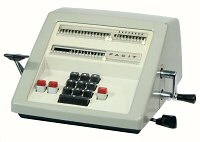 Facit Model CM2-16S, S/N 1099017, 1964
Facit Model CM2-16S, S/N 1099017, 1964
Digits: 11 keyboard, 9 counter, 16 accumulator
Dimensions: 240W x 275D x 155H, overall width 330mm
Weight: 7.5 kg
10-key keyboard, grey die-cast cover
Manufactured: Atvidaberg-Facit, Sweden, 1964
Model CM2-16S is a "Special" version of the CM2-16 which omits
the back-transfer mechanism. The machine has a different keyplate and
a revised pivot arrangement for the register clearing levers, but is
otherwise identical to the standard model. The published lists of
serial numbers suggest that only 30 units were ever built (199001 to
199030).
Facit CM2-16S nameplate
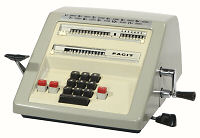 Facit Model CM2-13S, S/N 1099580, 1964
Facit Model CM2-13S, S/N 1099580, 1964
Digits: 9 keyboard, 8 counter, 13 accumulator
Dimensions: 240W x 275D x 155H, overall width 330mm
Weight: 7.5 kg
10-key keyboard, grey die-cast cover
Manufactured: Atvidaberg-Facit, Sweden, 1964-65
Model CM2-13S is another "Special" version of the CM2-16 in the
older 9 x 8 x 13 register configuration, and
without the back-transfer mechanism. The unwanted components were
simply left out during assembly.
Pinwheels 10 and 11 are still present and can be seen through the
setting window at the left of the rotor, but they are not fitted with
pins or setting rings. The accumulator carry drum still has all 16
places fitted, even though the register only has 13 places. The only
components that are actually different in the 13S are the keyplate
and register masks, the pivot post for the clearing levers, and a
couple of spacers to limit the rotor travel.
The CM2-13S was functionally equivalent to the smaller and cheaper
C1-13, and apparently was not a commercial success. Only a couple of
hundred units were made during a brief period in the mid-1960s. The
machine illustrated has a Sterling-currency conversion label above
the register windows, indicating that it was sold prior to 1966.
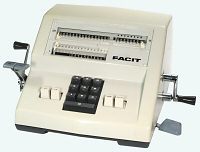 Facit Model 10-04, S/N 1902508, 1967
Facit Model 10-04, S/N 1902508, 1967
Digits: 11 keyboard, 9 counter, 16 accumulator
Dimensions: 240W x 275D x 155H, overall width 330mm
Weight: 7.5 kg
10-key keyboard, light grey plastic cover
Manufactured: Facit AB, Sweden, 1967-1969
The Facit model range was reorganised again in 1967, with new model
numbers in a 10-XX series. Model 10-04 is essentially the same as
the well-established CM2-16, but with a plastic housing, a much
lighter colour scheme, and a pull-out carry handle at the front.
Motor-driven calculators - with 2-row keyboard.
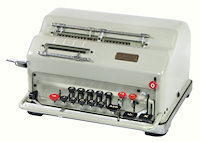 Facit Model NEA, S/N 286252, 1949
Facit Model NEA, S/N 286252, 1949
Digits: 9 keyboard, 8 counter, 13 accumulator
Dimensions: 265W x 250D x 165H
Weight: 10.2 kg
Dalton keyboard, grey pressed-metal cover
Manufactured: Sweden, 1943-1956
Facit's first electrically-driven calculators from the mid-1930s
just used the motor to replace the winding handle. As additional
automatic functions were added, the mechanical control systems became
more and more complex, with operating levers sprouting from any
available location.
This electric Model NEA from the 1940s is based on the 13-digit TK
mechanism. The machine is deeper and wider than the TK, with the motor
drive located at the rear and the mechanical control system at the
right-hand end. The Model NEA performs fully automatic division and
semi-automatic multiplication, but register clearing is still done
manually by the handles on the left.
The machine illustrated was built in 1949, and was the main
office calculator for a firm of surveyors in Melbourne during the
1950s. It continued in everyday use until replaced by a programmable
electronic calculator in the early 1970s.
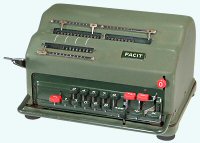 Facit Model NE, S/N 428833, 1954
Facit Model NE, S/N 428833, 1954
Digits: 9 keyboard, 8 counter, 13 accumulator
Dimensions: 265W x 250D x 165H
Weight: 9.6 kg
Dalton keyboard, green pressed-metal cover
Manufactured: Atvidaberg-Facit, Sweden, 1953-1956
The Model NE was produced for a short period in the mid-1950s as
a simpler and cheaper alternative to the Model NEA. Its only automated
feature is a mechanism which trips the main clutch when underflow
occurs during division.
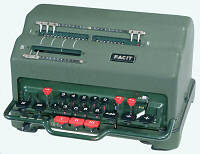 Facit Model ESA-0, S/N 349720, 1953
Facit Model ESA-0, S/N 349720, 1953
Digits: 9 keyboard, 8 counter, 13 accumulator
Dimensions: 280W x 260D x 180H
Weight: 12.4 kg
Dalton keyboard, green pressed-metal cover
Manufactured: Atvidaberg-Facit, Sweden, 1949-1956
Facit's first fully-automatic calculator was the Model ESA (Electric
Super-Automat) from 1945. The ESA extended the functions of the Model NEA
(above) to include an automatic 8-digit multiplier, but it retained the
manual clearing levers. Model ESA-0 from 1949 added a motorised clearing
mechanism with three additional keys at the lower front. The keys and
registers are numbered I, II, and III in left-to right order.
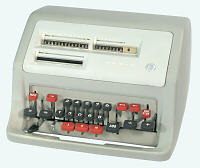 Facit Model CA1-13, S/N 677450, 1959
Facit Model CA1-13, S/N 677450, 1959
Digits: 9 keyboard, 8 counter, 13 accumulator
Dimensions: 280W x 280D x 190H
Weight: 12.6 kg
Dalton keyboard, light grey die-cast cover
Manufactured: Atvidaberg-Facit, Sweden, 1956-1973
Model ESA-0 was re-styled in 1956 to become Model CA1-13. The
one-piece pressed-metal case was replaced with a two-part die-cast
cover finished in a light two-tone grey. The Facit name is embossed
into the upper section and appears on the small round badge below
the counter register.
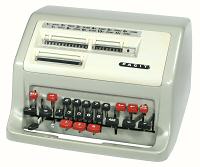 Facit Model CA1-13, S/N 1127360, 1963
Facit Model CA1-13, S/N 1127360, 1963
Digits: 9 keyboard, 8 counter, 13 accumulator
Dimensions: 280W x 280D x 190H
Weight: 12.6 kg
Dalton keyboard, light grey/yellow die-cast cover
Manufactured: Atvidaberg-Facit, Sweden, 1956-1973
This CA1-13 from 1963 uses an AC capacitor-run motor instead of the
earlier universal (brush-type) motor. The only external changes are to
the colour scheme and the Facit badge on the top panel.
 Facit Model CA1-13, S/N 1161579, 1964
Facit Model CA1-13, S/N 1161579, 1964
Digits: 9 keyboard, 8 counter, 13 accumulator
Dimensions: 290W x 285D x 195H
Weight: 13.0 kg
Dalton keyboard, medium grey die-cast cover
Manufactured: Atvidaberg-Facit, Sweden, 1956-1973
A 1964 version of the CA1-13 in a more angular one-piece case,
finished in a monotone grey gloss. This numbering of the registers
has been reversed in this (and subsequent) versions - the setting
register is now labelled I and the accumulator III.
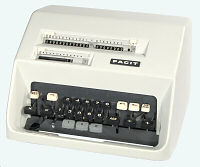 Facit Model CA1-13, S/N 1262531, 1970
Facit Model CA1-13, S/N 1262531, 1970
Digits: 9 keyboard, 8 counter, 13 accumulator
Dimensions: 290W x 285D x 195H
Weight: 12.7 kg
Dalton keyboard, light grey die-cast cover
Manufactured: Facit AB, Sweden, 1956-1973
A late-model CA1-13 in the light grey colour scheme. This model
continued until the end of calculator production in 1973.
Motor-driven calculators - with 10-key keypad.
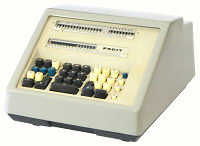 Facit Model CA2-16, S/N 1514572, 1964
Facit Model CA2-16, S/N 1514572, 1964
Digits: 11 keyboard, 9 counter, 16 accumulator
Memory: 8-digit internal memory register
Dimensions: 275W x 350D x 190H
Weight: 15.5 kg
10-key keyboard, grey die-cast cover
Manufactured: Sweden, 1962-1969
Original Owner: Royal Melbourne Institute of Technology
Facit Model CA2-16 from the 1960s is a fully-automatic machine with
a 10-key numeric keypad and fully push-button operation. It is based on
the 16-digit pin-wheel mechanism of the CM2-16 manual machine (above).
The keypad enters values directly into the 11-digit pinwheel rotor,
and into an 8-place pinbox register which is used for multiplier or
constant storage. The machine performs "short-cut" multiplication, and
operates at 400 cycles per minute. The rotor travels the full width of
the machine, so that it can engage with either the accumulator or the
counter register. The rotor can receive back-transferred values from
either register, allowing on-going calculations involving the results
of a division, and it can transfer values between the registers,
allowing the counter to be used as a memory or for the accumulation
of products.
Fully-automatic mechanical calculators were complex and expensive
machines, which were beyond the means of individuals and many
businesses. This machine originally belonged to the Royal Melbourne
Institute of Technology (now RMIT University), where it was used for
teaching in the Department of Mathematics.
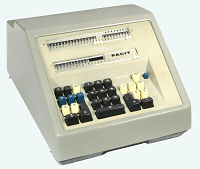 Facit Model CA2-16SX, S/N 1706651, 1966
Facit Model CA2-16SX, S/N 1706651, 1966
Digits: 11 keyboard, 9 counter, 16 accumulator
Memory: 8-digit internal memory register
Dimensions: 275W x 350D x 190H
Weight: 15.4 kg
10-key keyboard, grey die-cast cover
Manufactured: Sweden, 1965-1967
The Model CA2-16SX is basically identical to the CA2-16 above, but
without the accumulation and back-transfer functions on the counter
register (Register II).
 Facit Model 10-07, S/N 1571422, 1970
Facit Model 10-07, S/N 1571422, 1970
Digits: 11 keyboard, 9 counter, 16 accumulator
Memory: 8-digit internal memory register
Dimensions: 275W x 350D x 190H
Weight: 15.0 kg
10-key keyboard, grey plastic cover
Manufactured: Sweden, 1967-1972
Original Owner: Deakin University, Geelong
Model 10-07 from the late 1960s was the last of the Facit
motor-driven calculators. It is functionally the same as the Model
CA2-16 (above), but with some minor internal changes and a re-styled
plastic casing instead of the alloy die-casting.
The "simplified" Model CA2-16SX was similarly re-styled to become
Model 10-06.
Facit 10-07 keyboard detail (29kb)
Electronic calculators
In 1966 Facit introduced the first of a range of electronic
calculators manufactured by
Sharp
in Japan. The Facit machines had their own distinctive case designs,
but the internals were generally similar or identical to the machines
sold under Sharp's own brand. The electronic machines were sold in
parallel with Facit's traditional mechanical calculators, but were
initially much more expensive. The prices reached parity in about
1972, which effectively marked the end of mechanical calculator
production.
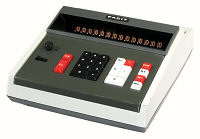 Facit Model 1124, S/N 403253
Facit Model 1124, S/N 403253
Functions: ASMD, 1 memory
Technology: Bipolar DTL (Mitsubishi, 151 chips), shift register memory
Display: 14 digit, Nixie tubes
Dimensions: 275W x 325D x 120H, weight 5.16kg
Manufactured: Sharp, Japan, 1968
The Facit 1124 from 1968 is a substantial but very basic
four-function desk calculator with a 14-digit display and one
user-accessible memory. The internal circuitry is typical of the
transition from discrete-transistor to first-generation (SSI)
integrated circuit design.
More...
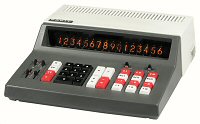 Facit Model 1135J, S/N 3500315
Facit Model 1135J, S/N 3500315
Functions: ASMD, K, square root, 3 memories
Technology: MOS-LSI (Rockwell, 7 chips)
Display: 16 digit, Nixie tubes
Dimensions: 300W x 330D x 105H, weight 4.24kg
Manufactured: Sharp, Japan, 1971
This Facit Model 1135J from 1971 is a (relatively) compact desktop
machine with a 16-digit display and three accessible memories. The
150 SSI chips of the first-generation machines have been condensed
into a set of just seven MOS-LSI chips from Rockwell in America.
More...
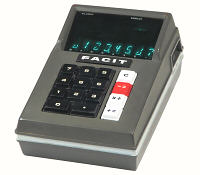 Facit Model 1111, S/N 1112353
Facit Model 1111, S/N 1112353
Functions: ASMD
Technology: MOS-LSI (4 chips), portable, NiCad batteries
Display: 8 digit, vacuum fluorescent tubes
Dimensions: 110W x 165D x 75H, weight 0.7kg
Manufactured: Sharp, Japan, 1970-71
This Facit Model 1111 is a re-packaged version of the famous
Sharp EL-8. The Sharp machine was introduced in November 1970, and is
generally accepted as the world's first battery-powered portable
electronic calculator. The CPU chips in this machine have date codes
from October 1970 to January 1971. The display board is dated
46.8.23 (23 August 1971) in the traditional Japanese format. A detailed
description of the underlying Sharp EL-8 is available via the
Sharp page.
Facit 1111 (Sharp EL-8) logic board (39kb).
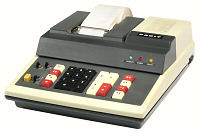 Facit Model 1148/0002, S/N 4823812
Facit Model 1148/0002, S/N 4823812
Functions: ASMD, K, percent, 1 memory
Technology: MOS-LSI (NEC, 2 chips)
Display: 15 column impact printer
Dimensions: 260W x 320D x 115H, weight 4.45kg
Manufactured: Sharp, Japan, late 1973
The Facit Model 1148 is a print-only desktop calculator in a casing
similar to the
Sharp CS-743R
from early 1973, but with the same chipset and printer as the later
Sharp CS-523.
When performing addition and subtraction the calculator operates in
the same manner as the long-established mechanical adding and listing
machines. Entries are printed in response to the add and subtract keys,
and results are obtained with the separate total and sub-total keys.
Multiplication and division operate algebraically. Entries or results
can be added to (or subtracted from) the memory register, and retrieved
with the memory total and sub-total functions. A switch setting allows
currency amounts to be entered without using the decimal point key.
Internal view (29kb)
Facit accessories
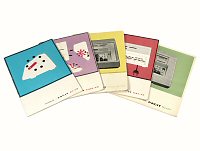 Facit Instruction Manuals
Facit Instruction Manuals
The Facit instruction manuals and operators' handbooks are very
clear and well-written. They describe all the controls and functions
of the machines, and give plenty of worked examples from a wide range
of calculations. Reproductions of some of the Facit handbooks are
listed on the Manuals page.
 "Facit Man"
"Facit Man"
"Facit Man" appeared as a cartoon character (left) in many of the
Facit instruction manuals from the 1950s and early 60s. He also existed
as a hand-painted plastic figure (right) about 100mm high, which was
sometimes used as a promotional gift for customers and prospects. The
figure has magnets in its feet so that it can stand on top of the
calculator while it is operating.
Resources for further information:
- Karl Rudin's development of the characteristic Facit design with
the "inverted" pinwheel mechanism and Dalton keyboard is described
(in English) in his US Patent 2108596. The application was filed
in the USA in 1930.
- Christofer Noering's
Swedish Typewriter Page
(in Swedish and English) has a history of Facit calculators, including
a chart of the various models and features, and a table of dates and
serial numbers.
- For those who read German,
Harald Schmidt's web site
has a detailed history of the Facit organisation, and a wealth of
information on the many calculator models and variations.
- Technical descriptions of the mechanisms of a basic hand-cranked
Facit (Model C1-13) and of a fully-automatic machine (Model CA2-16)
are available in the
Technical Section of this site.
Original text and images Copyright © John Wolff 2002-2021.
Last Updated: 26 February 2021 - updated Model TK.
Back to:
Home
Calculating Machines
Pinwheel Calculators

 The "Facit" company was established in Stockholm in 1918 to build
a line of pin-wheel calculators based on the
The "Facit" company was established in Stockholm in 1918 to build
a line of pin-wheel calculators based on the


































